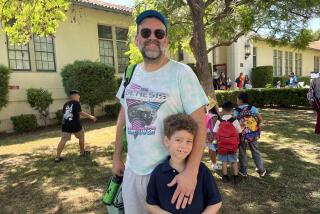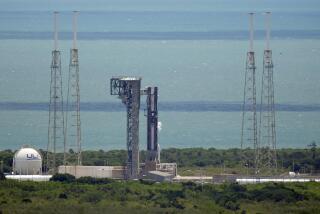SANTA ANA : Students Get Lesson on Trial and Error
- Share via
Modern science has been built upon the process of trial and error. Friday afternoon at Santa Ana High School, about 25 students in the school’s science club received a lesson more about error than trial.
With the help of Comcast Cablevision and scientists from McDonnell Douglas, the students were expecting to operate a land rover at a NASA facility near San Jose via remote control from their Santa Ana classroom.
Had all gone according to plan, the students would have been able to maneuver the camera-equipped vehicle forward, backward and sideways with their classroom television and computer.
Scientists are planning to send a land rover to Mars by 1997 as part of a joint Russian/American space venture. And cable companies like Comcast are counting on selling time to average citizens who have cable television and a home computer to operate the space vehicle from their living rooms. Cable companies don’t yet know how much driving the Mars vehicle by remote would cost yet.
Friday’s experiment was intended not only to encourage students to pursue careers in science, but also to help scientists refine and simplify commands for the vehicle.
By 3:30 p.m., everything was a go, except for one technical difficulty--the rover wasn’t working. Apparently, the cable which controls the machine got entangled in one of the vehicle’s propellers, rendering it temporarily inoperable.
“You guys are part of the learning process,” said John M. Garvey, who is managing the rover project for McDonnell Douglas. “We just happened to hit a day when we had some problems. You learn by doing.”
Despite the glitch, the students said they were impressed with the presentation and weren’t disappointed.
“Maybe it didn’t work this time, but they can always come back and try it again,” said Marcela Jimenez, 17, a senior and president of the science club. “I hope they do come back.”
“I still thought it was all right,” added Juan Bolanos, 16, a junior. “That was real interesting.”
Besides, the afternoon wasn’t a total bust.
The scientist explained the rover project to students and showed a videotape of a rover working underwater in the Antarctic Ocean. The class also established a connection with the NASA facility. A video phone link-up supplied the students with computer animation, which illustrated what the rover can do on land.
“This may have been disappointing,” said Garvey. “But we’ve proven you can at least get a video signal. And that’s good.”
The event will be rescheduled and the students will have another chance at operating the rover, said organizers.
In a summation of the afternoon, Gary Reynolds, chairman of the school’s science department, quoted an old science adage: “If it’s biology, it’s slimy. If it’s chemistry, it stinks. If it’s physics, which this is, it doesn’t work.”
More to Read
Sign up for Essential California
The most important California stories and recommendations in your inbox every morning.
You may occasionally receive promotional content from the Los Angeles Times.










